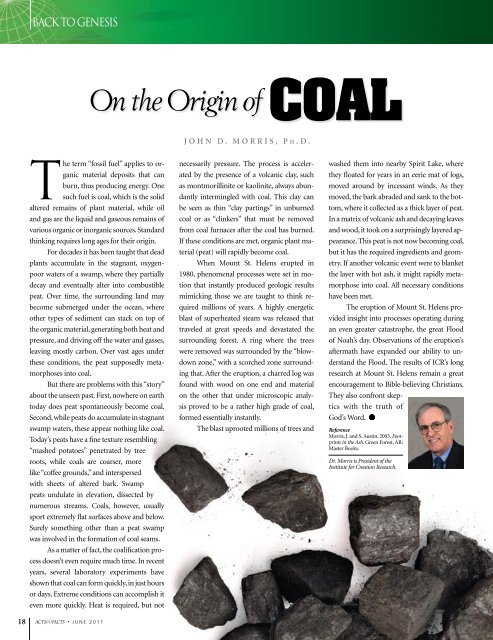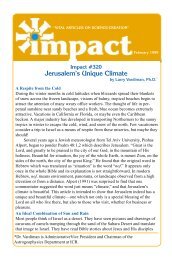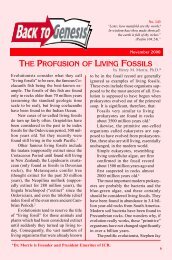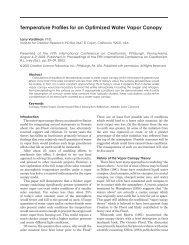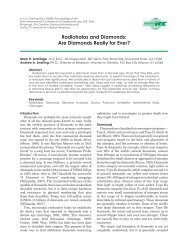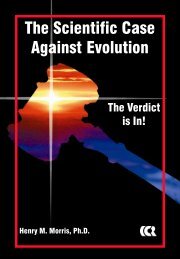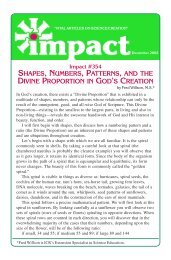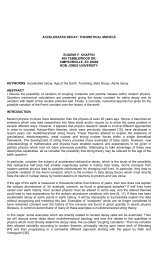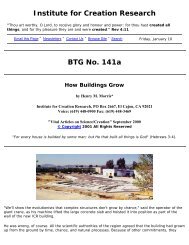Download June 2011 PDF - The Institute for Creation Research
Download June 2011 PDF - The Institute for Creation Research
Download June 2011 PDF - The Institute for Creation Research
You also want an ePaper? Increase the reach of your titles
YUMPU automatically turns print PDFs into web optimized ePapers that Google loves.
BACK TO GENESISOn the Origin of CoalJohn D. Morris, Ph .D.<strong>The</strong> term “fossil fuel” applies to organicmaterial deposits that canburn, thus producing energy. Onesuch fuel is coal, which is the solidaltered remains of plant material, while oiland gas are the liquid and gaseous remains ofvarious organic or inorganic sources. Standardthinking requires long ages <strong>for</strong> their origin.For decades it has been taught that deadplants accumulate in the stagnant, oxygenpoorwaters of a swamp, where they partiallydecay and eventually alter into combustiblepeat. Over time, the surrounding land maybecome submerged under the ocean, whereother types of sediment can stack on top ofthe organic material, generating both heat andpressure, and driving off the water and gasses,leaving mostly carbon. Over vast ages underthese conditions, the peat supposedly metamorphosesinto coal.But there are problems with this “story”about the unseen past. First, nowhere on earthtoday does peat spontaneously become coal.Second, while peats do accumulate in stagnantswamp waters, these appear nothing like coal.Today’s peats have a fine texture resembling“mashed potatoes” penetrated by treeroots, while coals are coarser, morelike “coffee grounds,” and interspersedwith sheets of altered bark. Swamppeats undulate in elevation, dissected bynumerous streams. Coals, however, usuallysport extremely flat surfaces above and below.Surely something other than a peat swampwas involved in the <strong>for</strong>mation of coal seams.As a matter of fact, the coalification processdoesn’t even require much time. In recentyears, several laboratory experiments haveshown that coal can <strong>for</strong>m quickly, in just hoursor days. Extreme conditions can accomplish iteven more quickly. Heat is required, but notnecessarily pressure. <strong>The</strong> process is acceleratedby the presence of a volcanic clay, suchas montmorillinite or kaolinite, always abundantlyintermingled with coal. This clay canbe seen as thin “clay partings” in unburnedcoal or as “clinkers” that must be removedfrom coal furnaces after the coal has burned.If these conditions are met, organic plant material(peat) will rapidly become coal.When Mount St. Helens erupted in1980, phenomenal processes were set in motionthat instantly produced geologic resultsmimicking those we are taught to think requiredmillions of years. A highly energeticblast of superheated steam was released thattraveled at great speeds and devastated thesurrounding <strong>for</strong>est. A ring where the treeswere removed was surrounded by the “blowdownzone,” with a scorched zone surroundingthat. After the eruption, a charred log wasfound with wood on one end and materialon the other that under microscopic analysisproved to be a rather high grade of coal,<strong>for</strong>med essentially instantly.<strong>The</strong> blast uprooted millions of trees andwashed them into nearby Spirit Lake, wherethey floated <strong>for</strong> years in an eerie mat of logs,moved around by incessant winds. As theymoved, the bark abraded and sank to the bottom,where it collected as a thick layer of peat.In a matrix of volcanic ash and decaying leavesand wood, it took on a surprisingly layered appearance.This peat is not now becoming coal,but it has the required ingredients and geometry.If another volcanic event were to blanketthe layer with hot ash, it might rapidly metamorphoseinto coal. All necessary conditionshave been met.<strong>The</strong> eruption of Mount St. Helens providedinsight into processes operating duringan even greater catastrophe, the great Floodof Noah’s day. Observations of the eruption’saftermath have expanded our ability to understandthe Flood. <strong>The</strong> results of ICR’s longresearch at Mount St. Helens remain a greatencouragement to Bible-believing Christians.<strong>The</strong>y also confront skepticswith the truth ofGod’s Word.ReferenceMorris, J. and S. Austin. 2003. Footprintsin the Ash. Green Forest, AR:Master Books.Dr. Morris is President of the<strong>Institute</strong> <strong>for</strong> <strong>Creation</strong> <strong>Research</strong>.18 ACTS&FACTS • JUNE <strong>2011</strong>


